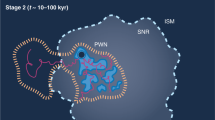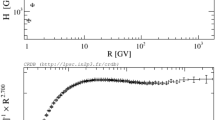Abstract
Many years ago physical and radio-astronomical arguments and data led to the assumption that cosmic rays in the Galaxy (and probably in other galaxies) fill a more or less extended halo, but are not concentrated in the disk. It was not so long ago, however, that the existence of a radio-halo was discovered, in which the effective dimensions increase with a decrease in frequency. The frequency decrease occurs when relativistic electrons diffuse from the disk, losing energy due to bremsstrahlung and Compton scattering.
Meanwhile, some ambiguity on the question of the existence of a radio-halo, and other reasons, have led to a rather wide use of disk models, particularly those in which cosmic rays are present in the Galaxy only for a periodT cr,d≲3×106 yr. The authors have repeatedly stated the inadmissibility of such models and, generally, a homogeneous (leaky box) model for the origin of cosmic rays. The new data concerning the amount of radioactive10Be nuclei in cosmic rays near the Earth in no way contradict the halo models in which the lifetime of cosmic rays isT cr,h∼108 yr. In connection with the continuing controversy, the present paper is devoted to a detailed consideration of the difference between the homogeneous and diffusion models. Within the latter models some calculations on the chemical composition of cosmic rays have been carried out, which concern not only stable but also radioactive isotopes.
Similar content being viewed by others
References
Allen, R. J., Baldwin, J. E. and Sancisi, R.: 1978,Astron. Astrophys. 62, 397.
Beck, R., Biermann, P., Emerson, D. T. and Wielebinski, R.: 1979,Astron. Astrophys. 77, 25.
de Bruyn, A. G. and Hummel, E.: 1979,Astron. Astrophys. 73, 196.
Buffington, A., Orth, C. D. and Mast, T. T.: 1978,Astrophys. J. 226, 335.
Bulanov, S. V., Dogiel, V. A. and Syrovatskii, S. I.: 1976,Astrophys. Space Sci. 44, 267.
Dogiel, V. A.: 1979,Proc. XVI Int. Cosmic Ray Conf. 2, 143.
Ekers, R. D. and Sancisi, R.: 1977,Astron. Astrophys. 54, 973.
Garcia-Munoz, M., Mason, G. M. and Simpson, J. A.: 1977,Astrophys. J. 217, 859.
Ginzburg, V. L.: 1976,Proc. XV Int. Cosmic Ray Conf., Plovidiv. Invited papers.
Ginzburg, V. L.: 1978,Uspekhi Phys. Nauk. 124, 307; English transl.Sov. phys. Uspekhi 21, 155.
Ginzburg, V. L.: 1979,Proc. XVI Int. Cosmic Ray Conf. 2, 148.
Ginzburg, V. L. and Ptuskin, V. S.: 1975,Proc. XIV Int. Cosmic Ray Conf., Munich 2, 695.
Ginzburg, V. L. and Ptuskin, V. S.: 1976a,Rev. Mod. Phys. 48, 161.
Ginzburg, V. L. and Ptuskin, V. S.: 1976b,Sov. Phys. Uspekhi 18, 931.
Ginzburg, V. L. and Syrovatskii, S. I.: 1964,Origin of Cosmic Rays, Pergamon Press.
Hagen, F. A., Fisher, A. J. and Ormes, J. F.: 1977,Astrophys. J. 212, 262.
Jones, F. C.: 1978,Astrophys. J. 222, 1097.
Khazan, Y. M. and Ptuskin, V. S.: 1977,Proc. XV Int. Cosmic Ray Conf., Plovidiv 2, 4.
Kodaira, K.: 1974,Publ. Astron. Soc. Japan 26, 255.
Ormes, J. and Freier, P.: 1978,Astrophys. J. 222, 547.
Owens, A. J. and Jokipii, J. R.: 1977,Astrophys. J. 215, 677.
Parker, E. N.: 1969,Space Sci. Rev. 9, 651.
Prischep, V. L. and Ptuskin, V. S.: 1975,Astrophys. Space Sci. 32, 265.
Prischep, V. L. and Ptuskin, V. S.: 1979,Proc. XVI Int. Cosmic Ray Conf. 2, 137
Prischep, V. L., Ptuskin, V. S. and Khazan, Y. M.: 1977,Proc. XV Int. Cosmic Ray Conf., Plovdiv 2, 695.
Ptuskin, V. S.: 1978,Astrophys. Space Sci. 58, 341.
Ptuskin, V. S. and Khazan, Y. M.: 1976,Astrophysika 1, 129.
Raisbeck, G. M. and Yiou, F.: 1976, in B. S. P. Shen and M. Marker (eds.),Spallating Nuclear Reactions and their Applications, D. Reidel Publishing Co., Dordrecht, Holland.
Shapiro, M. M. and Silberberg, R.: 1975,Phil. Trans. Roy. Soc. (London) A277, 317.
Silberberg, R. and Tsao, C. H.: 1973,Astrophys. J. Suppl. 25, 315.
Silberberg, R., Tsao, C. H. and Shapiro, M. M.: 1976, in B. S. P. Shen and M. Marker (eds.),Spallating Nuclear Reactions and their Applications, D. Reidel Publishing Co., Dordrecht, Holland.
Webber, W. R., Lezniak, J. A., Kish, J. C. and Simpson, G. A.: 1977,Astrophys. Letters 18, 125.
Webster, A.: 1978,Monthly Notices Roy. Astron. Soc. 185, 527.
Author information
Authors and Affiliations
Rights and permissions
About this article
Cite this article
Ginzburg, V.L., Khazan, Y.M. & Ptuskin, V.S. Origin of cosmic rays: Galactic models with halo. Astrophys Space Sci 68, 295–314 (1980). https://doi.org/10.1007/BF00639701
Received:
Issue Date:
DOI: https://doi.org/10.1007/BF00639701




